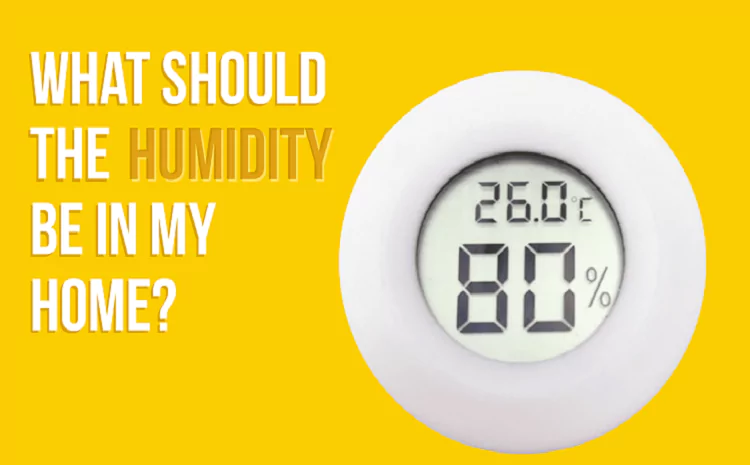Maintaining the right humidity level is crucial for your comfort, health, and even the condition of your home. But how much should the humidity be in a room? The ideal humidity indoors should be kept below 60% to avoid mold growth, while a range of between 30% and 50% is generally comfortable and healthy.
Key Takeaways
- Ideal indoor humidity: Keep it between 40% and 60% for a balance between comfort and health.
- Humidity levels should be monitored, especially in rooms like bedrooms, to ensure good air quality.
- Low humidity can cause dry skin and respiratory issues, while high humidity can lead to mold and dust mites.
- Using a humidifier or dehumidifier can help you maintain optimal levels.
Why is Room Humidity Important?
Humidity impacts the air quality and your well-being. If it’s too high or too low, you might experience discomfort or even health issues. The humidity indoors influences:
- Respiratory health: Too much humidity can worsen allergies or asthma. Too little humidity can dry out your sinuses.
- Comfort: Feeling sticky in summer? That’s often due to high humidity levels.
- Home condition: High moisture can damage wooden furniture or walls.
To maintain the ideal balance, indoor humidity should stay below 60% but not drop below 30%.
Recommended Humidity Levels for Different Rooms
It’s important to know the recommended humidity for various parts of the house. Here’s a breakdown:
| Room | Ideal Humidity | Concerns if Too High or Low |
|---|---|---|
| Living Room | 40% to 50% | Mold growth above 60%, dry skin below 30% |
| Bedroom | 40% to 60% | Dust mites above 60%, disrupted sleep below 30% |
| Basement | 30% to 50% | Mold, mildew, and foundation damage above 60% |
| Kitchen/Bathroom | 40% to 60% | High humidity can lead to condensation and mold |
| Nursery | 40% to 50% | Dry air can cause breathing issues for babies |
Understanding Relative Humidity
Humidity is the amount of moisture in the air, and we often measure it as a percentage. When we say 40% to 50% humidity, it means that the air holds 40-50% of the maximum amount of moisture it can at that temperature.
Keeping the humidity within the range of between 40%-60% can help prevent mold, improve comfort, and maintain a healthier environment.
Why Between 30% and 50% Humidity is Ideal?
Maintaining humidity between 30% and 50% in your house provides the right balance between dryness and moisture. If the air is too dry (below 30%), it can cause:
- Dry skin
- Nosebleeds
- Cracked wood furniture
When the humidity exceeds 60%, it can encourage:
- Mold and mildew growth
- Dust mites
- Peeling wallpaper
Bedroom Humidity
When it comes to your bedroom, keeping the indoor humidity between 40% to 50% is optimal for a restful night’s sleep. Higher levels can make the room feel stuffy, causing disturbed sleep or even respiratory discomfort. Keep a humidifier or dehumidifier handy to ensure your indoor humidity stays comfortable.
How to Measure and Control Room Humidity?
Tools to Measure Humidity
To check if your home’s humidity indoors is at the right level, you can use:
- Hygrometers: A simple tool that gives you the room’s humidity level.
- Smart Thermostats: Many of these include humidity monitoring as well.
- Humidity Sensors: These can be integrated into your HVAC system.
How to Control Humidity?
Here’s how you can adjust the indoor humidity in your house:
| Situation | Solution |
|---|---|
| Humidity Below 30% | Use a humidifier to add moisture back into the air. |
| Humidity Above 60% | Use a dehumidifier or an air conditioner to remove excess moisture. |
| Humidity fluctuating too much | Consider getting a smart thermostat to regulate both temperature and humidity levels. |
Maintaining indoor humidity can be as simple as using a humidifier during winter months and a dehumidifier in the summer. Keep in mind that some rooms, like the basement or bathroom, might need more control due to fluctuating moisture levels.
Tips for Maintaining Ideal Indoor Humidity
- Use exhaust fans in kitchens and bathrooms to control moisture.
- Seal windows and doors to prevent excess moisture from seeping in.
- Use house plants that naturally help control humidity, like peace lilies or ferns.
Health Implications of Improper Humidity Levels
When humidity levels go above 60%, it creates an environment where allergens like mold and dust mites thrive. Mold exposure can lead to respiratory issues, especially for those with asthma or allergies.
Low humidity, on the other hand, can dry out your skin and mucous membranes, leading to discomfort. This is especially common in winter when the air is cold and dry.
Final Thoughts
keeping your indoor humidity between 40%-60% is ideal for comfort, health, and maintaining your home’s condition. Regularly check the humidity levels in your house to ensure it stays below 60%, especially in rooms like the bedroom or living room. By keeping an eye on humidity indoors, you’ll improve air quality, reduce allergens, and feel more comfortable year-round.









